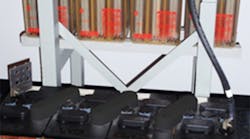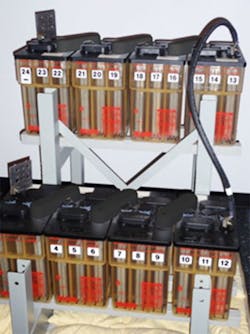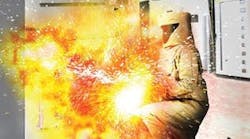Substations are prevalent in all petrochemical facilities. Their function is to distribute power to the process units. Typically, there are either one or two types of battery systems within each substation. There may be a “station power” battery system to power the switchgear controls, which typically operates at 125VDC. There might also be an uninterruptible power supply (UPS) battery system in place for critical loads, such as egress lighting, emergency shutdown valves, etc., that must be energized if there is a power failure.
In the U.S., these battery systems are subject to the provisions of National Electrical Code (NEC) [Art. 480]. There are no requirements to place the batteries within a separate enclosure, if the room is available only to qualified persons. This isn’t typically a problem because most plants only allow qualified persons in a substation. However, if the battery terminals are exposed, then the requirements of Sec. 110.27 come into play. This Section of the Code includes a provision that warning signs be posted on the doors of the substation forbidding unqualified persons from entering.
Most plants place their batteries in ventilated PMMA (Plexiglas) enclosures to give personnel some protection from the battery terminals. Sometimes, the PMMA enclosure is vented to the room. Other times, there may be an exhaust fan to the outdoors. The enclosure offers protection from inadvertently touching the live parts. But just because you may only have qualified personnel in the substation, this doesn’t mean that someone couldn’t accidentally drop a tool on the batteries or touch the energized parts. There’s also the chance of an unqualified person ignoring the warning sign and entering the substation. So some sort of protective, ventilated enclosure is always recommended where the batteries are capable of coming in contact with personnel.
Adequate illumination must also be provided around these battery banks. Most substations have emergency lighting that automatically kicks on when the normal power feed is lost. While the emergency feature isn’t a requirement in Sec. 480.9, it is a great idea to provide this safety component where live parts are exposed.
One oft violated Section of the NEC is 480.9(C). The working space from the front of the batteries should be measured from the farthest protrusion from the battery equipment. Most of the time this will be the battery drip pan located beneath the battery racks — or possibly the battery racks themselves. The pan typically protrudes in front of the rack and on the sides, where the batteries are mounted against a wall. In large substations, the batteries may be out in the middle of the floor with the pan protruding all the way around the battery rack. Erroneously, the measurements for the required working space about the batteries are many times taken from the terminals of the batteries.
As for the disconnecting means and overcurrent protection for the battery conductors, Sec. 480.6 requires a disconnecting means to be located within sight (within visual sight and 50 ft) and readily accessible to the batteries where the voltage exceeds 50V, nominal. The disconnecting means must disconnect all ungrounded conductors, but doesn’t have to include an integral overcurrent protective device. The disconnecting means may have to break both the positive and negative poles of the batteries, as many battery systems are ungrounded. The conductor overcurrent device provision is located in Sec. 240.21(H). One would intuitively think that the battery conductor overcurrent protection would be limited to something like a tap rule. But, this isn’t the case. The way the Code is written today, the overcurrent protective device can be as near or far from the batteries as you would like to locate it.
Hydrogen off-gassing is another issue that often arises when dealing with batteries in a substation. The design engineer should consult American Petroleum Institute Recommended Practice 500 to determine ventilation and classification requirements whenever batteries are installed indoors. This is typically only an issue with flooded cell battery types, not gel cells.
Before designing or installing a battery system, the electrical designer or electrician should be very familiar with all of the hazards involved, as well as the minimum safety requirements of the NEC.
© 2015 Fluor Corporation. All Rights Reserved.




